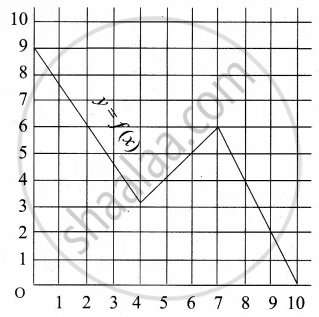Advertisements
Advertisements
Question
If 2f (x) − \[3f\left( \frac{1}{x} \right) = x^2\] (x ≠ 0), then f(2) is equal to
Options
(a) \[- \frac{7}{4}\]
(b) \[\frac{5}{2}\]
(c) −1
(d) None of these
Solution
(a) \[- \frac{7}{4}\]
2f (x) − \[3f\left( \frac{1}{x} \right) = x^2\] (x ≠ 0) ....(1)
\[\text{ Replacing x by } \frac{1}{x}: \]
\[2f\left( \frac{1}{x} \right) - 3f(x) = \frac{1}{x^2} . . . (2) \]
\[\text{ Solving equations (1) & (2) } \]
\[ - 5f (x) = \frac{3} {x^2} + 2 x^2 \]
\[ \Rightarrow f(x) = \frac{- 1}{5} \left( \frac{3}{x^2} + 2 x^2 \right)\]
\[\text{ Thus } , f(2) = \frac{- 1}{5} \left( \frac{3}{4} + 2 \times 4 \right)\]
\[ = \frac{- 1}{5} \left( \frac{3 + 32}{4} \right) \]
\[ = \frac{- 7}{4}\]
APPEARS IN
RELATED QUESTIONS
f, g, h are three function defined from R to R as follow:
(iii) h(x) = x2 + 1
Find the range of function.
If f(x) = x2 − 3x + 4, then find the values of x satisfying the equation f(x) = f(2x + 1).
Let f and g be two real functions defined by \[f\left( x \right) = \sqrt{x + 1}\] and \[g\left( x \right) = \sqrt{9 - x^2}\] . Then, describe function:
(v) \[\frac{g}{f}\]
If\[f\left( x \right) = 1 - \frac{1}{x}\] , then write the value of \[f\left( f\left( \frac{1}{x} \right) \right)\]
If f(x) = 4x − x2, x ∈ R, then write the value of f(a + 1) −f(a − 1).
If f(x) = cos (loge x), then \[f\left( \frac{1}{x} \right)f\left( \frac{1}{y} \right) - \frac{1}{2}\left\{ f\left( xy \right) + f\left( \frac{x}{y} \right) \right\}\] is equal to
The domain of the function
The domain of definition of the function \[f\left( x \right) = \sqrt{x - 1} + \sqrt{3 - x}\] is
The range of the function \[f\left( x \right) = \frac{x + 2}{\left| x + 2 \right|}\],x ≠ −2 is
Let \[f\left( x \right) = \sqrt{x^2 + 1}\ ] . Then, which of the following is correct?
The range of \[f\left( x \right) = \frac{1}{1 - 2\cos x}\] is
Check if the following relation is function:

If f(x) = `{(x^2 + 3"," x ≤ 2),(5x + 7"," x > 2):},` then find f(2)
Check if the relation given by the equation represents y as function of x:
x2 − y = 25
If f(m) = m2 − 3m + 1, find f(−3)
If f(m) = m2 − 3m + 1, find `f(1/2)`
If f(m) = m2 − 3m + 1, find f(x + 1)
Express the following exponential equation in logarithmic form
`9^(3/2)` = 27
Express the following logarithmic equation in exponential form
`log_5 1/25` = – 2
Prove that logbm a = `1/"m" log_"b""a"`
Solve for x.
x + log10 (1 + 2x) = x log10 5 + log10 6
If x = loga bc, y = logb ca, z = logc ab then prove that `1/(1 + x) + 1/(1 + y) + 1/(1 + z)` = 1
Select the correct answer from given alternatives.
If log10(log10(log10x)) = 0 then x =
A function f is defined as : f(x) = 5 – x for 0 ≤ x ≤ 4. Find the value of x such that f(x) = 3
Answer the following:
Let f : R → R be given by f(x) = x + 5 for all x ∈ R. Draw its graph
Answer the following:
Solve for x, logx (8x – 3) – logx 4 = 2
Answer the following:
If `log_2"a"/4 = log_2"b"/6 = log_2"c"/(3"k")` and a3b2c = 1 find the value of k
Given the function f: x → x2 – 5x + 6, evaluate f(2a)
A graph representing the function f(x) is given in it is clear that f(9) = 2

Find the following values of the function
(a) f(0)
(b) f(7)
(c) f(2)
(d) f(10)
Let f(x) = 2x + 5. If x ≠ 0 then find `(f(x + 2) -"f"(2))/x`
The data in the adjacent table depicts the length of a person's forehand and their corresponding height. Based on this data, a student finds a relationship between the height (y) and the forehand length (x) as y = ax + b, where a, b are constant.
| Length ‘x’ of forehand (in cm) |
Height 'y' (in inches) |
| 35 | 56 |
| 45 | 65 |
| 50 | 69.5 |
| 55 | 74 |
Find a and b
Mapping f: R → R which is defined as f(x) = sin x, x ∈ R will be ______
Find the range of the following functions given by `sqrt(16 - x^2)`
Find the range of the following functions given by f(x) = `3/(2 - x^2)`
The domain and range of the function f given by f(x) = 2 – |x – 5| is ______.
The ratio `(2^(log_2 1/4 a) - 3^(log_27(a^2 + 1)^3) - 2a)/(7^(4log_49a) - a - 1)` simplifies to ______.
Let f be a function with domain [–3, 5] and let g(x) = | 3x + 4 |. Then, the domain of (fog) (x) is ______.
Range of the function f(x) = `x/(1 + x^2)` is ______.
The domain of f(x) = `sin^-1 [log_2(x/2)]` is ______.
